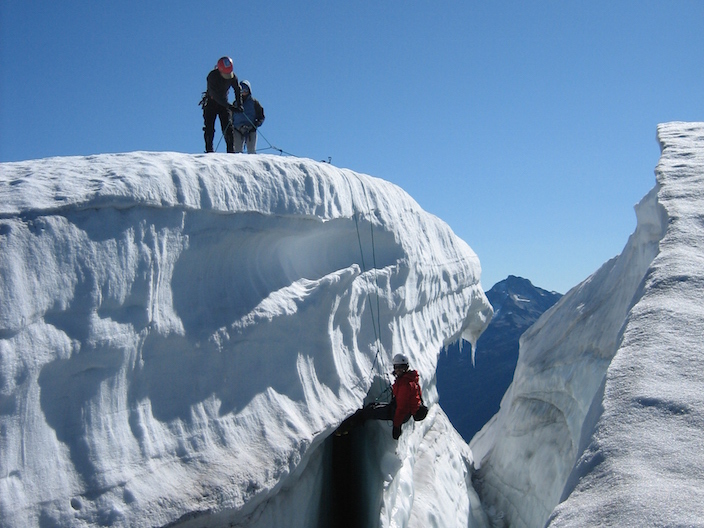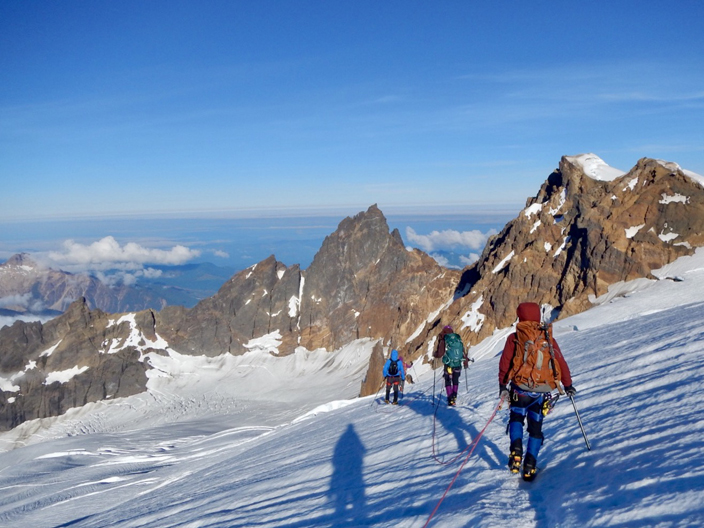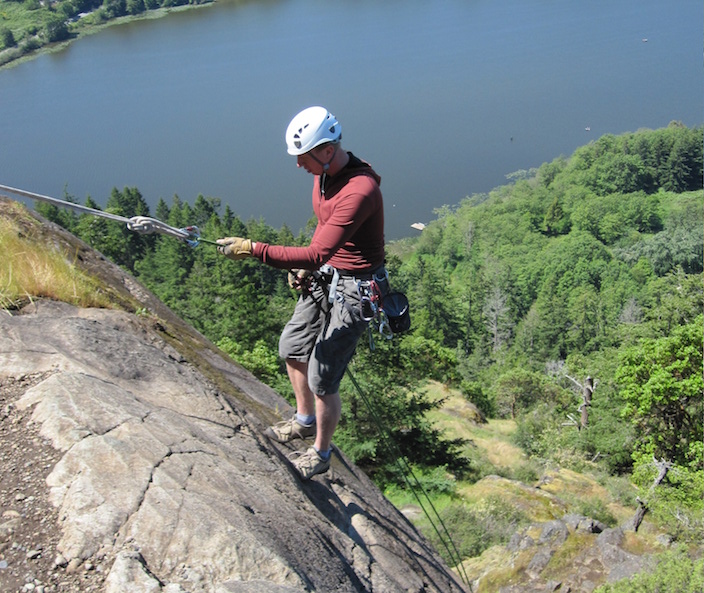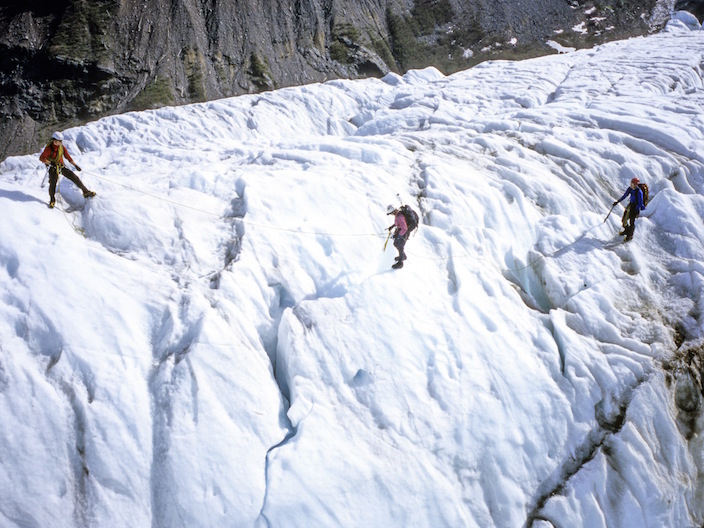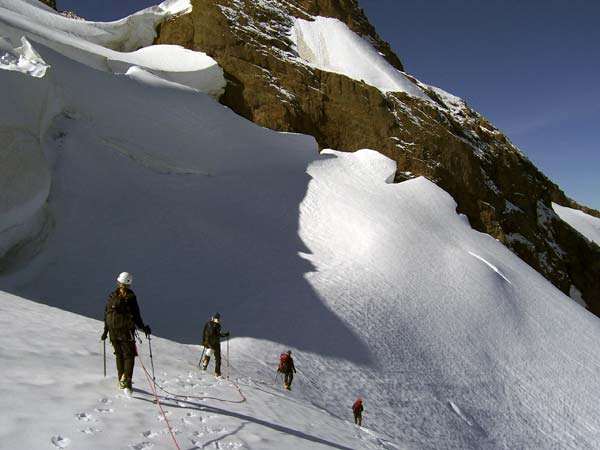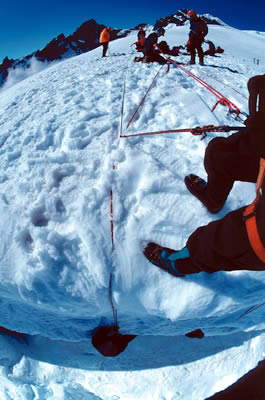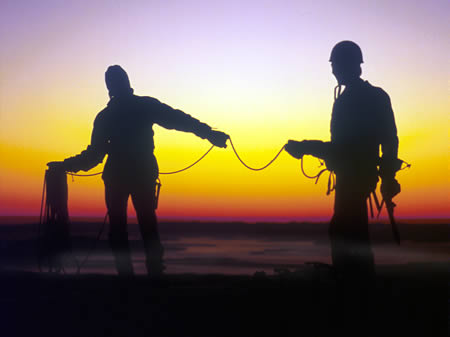Alpinism 1 - Introduction to Mountaineering Overview The Outdoor Life Network included this course in a recent series on America's Top 10 Adventure Sports Camps. This is definitely not a "camp" in the traditional sense, rather it is a rigorous alpine climbing course with small groups (maximum 10 climbers) in a remote wilderness setting. It is one of AAI's classics and perhaps the most comprehensive one-week climbing course in the nation, unbeatable for its combination of fun, learning, and achievement.
Alpinism 1 from John Grace on Vimeo .
The course provides a complete introduction to off-trail alpine travel and to all the fundamental skills of rock, snow, and ice climbing. We spend one day in an easily accessible rock climbing area, and five days learning and applying the skills of glacier travel and snow and ice climbing. On the fifth day, we set up a high glacier camp (with some of the most remarkable mountain and ocean views in America), and on the final day, we climb to the rugged, ice-encrusted summit of 10,778-foot Mt. Baker.
The incredible Sherman Crater of Mt. Baker. The final push to the summit skirts the crater rim on the left and ascends the snow slope called the 'Roman Wall' to the left of the photo. Ryan Slaybaugh
The Intro to Alpinism course is conducted largely above timberline in the high country of North Cascades National Park and Mt. Baker National Forest . Distances covered while backpacking into our base camps are kept to a minimum, usually about four miles, because of our emphasis on skills development and practice climbing.
You'll come away awed by the terrain you have seen, proud of your accomplishments, and you will have the knowledge and experience to operate as a skilled rope team member on climbs of intermediate difficulty.
Alpinism 1 - Introduction to Mountaineering Curriculum Our principal goals in this program are:
To make mountain enthusiasts with little or no previous climbing experience capable of gaining safe access to trailless, wilderness alpine areas.
To make them proficient in all basic alpine mountaineering skills for rock, snow, and ice.
To help them understand and protect the fragile alpine environment. We work hard to instill in participants an appreciation of both specific concepts and specific techniques that will allow them to travel through and climb in alpine areas skillfully, confidently, and without leaving a trace.
Upon completion of the program, each participant should be qualified as a technically competent rope team member capable of making alpine mountaineering ascents on routes of intermediate difficulty.
Curriculum Details An AAI group takes a break during 'snow school' to show their enthusiasm for learning new skills. Dyan Padagas
This course is intended to serve as an intensive and complete introduction to off-trail alpine travel, and to all the fundamental alpine mountaineering skills of rock, snow, and ice climbing. The course is presented in the most highly glaciated area in the conterminous forty-eight states and offers exposure to an unusually large variety of landforms and climbing surfaces. Groups are small and individual attention is very great, allowing instructors to respond to participants who are progressing at different rates or who want emphasis on different parts of the curriculum.
Climbing Skills:
Selection and use of personal equipment
Selection and use of ropes, knots, and harnesses
Selection and use of rock, snow, & ice anchors for belays & intermediate protection
Belaying techniques on rock, snow, and ice
Free climbing techniques on low and high angle rock, snow, and ice
Principles of glacier travel & route finding
Self-arrest; rappelling, & prusiking
The concept and application of the self-belay
Individual & team crevasse rescue techniques
General Mountain Skills:
Leave No Trace travel, camping, and climbing
An introduction to alpine ecology
Map, compass, altimeter and GPS use: reading, intersection, and triangulation
Evaluation and prediction of mountain weather patterns
Introduction to avalanche hazard evaluation
Introduction to first aid and the evacuation of injured climbers
Save
Save
Save
Alpinism 1 - Introduction to Mountaineering Itinerary We meet at AAI's headquarters in Bellingham, WA to check gear and take care of any rental equipment needed. We spend several hours on equipment, answering questions, and making sure everyone has what they need to make the week a success.
Climbers coil their rope at the end of a great day at Mt. Erie.
By mid-morning we head for the climbing, driving south just an hour to Mt. Erie, a coastal crag overlooking northern Puget Sound and the beautiful San Juan Islands in three directions, and looking out to glacier covered Mt. Baker in the other. The rock at Mt. Erie is excellent, and the moderate routes provide a perfect training area for covering all the basics of free climbing, rappelling, anchor placement, and belaying. We practice hand and foot placements and knot tying, and each team member spends substantial time belaying and climbing a variety of short routes. By the end of the day, you should feel confident on mid-fifth class rock, have a clear sense of how ropes and protective systems work, and be able to climb moderate rock with ease.
The next day we make the short drive to Mt. Baker. We drive a Forest Service road to an elevation of 3200 feet, and then make a moderate hike of about five miles through climax fir forest and sub-alpine terrain to the edge of either the Easton Glacier or the Squak Glacier. Depending on the time of year, the trail can provide views of a remarkable array of wildflowers in the sub-alpine zones. We set up our base camp on a lateral moraine of the glacier which gives us easy access to the glacier and views across it to Mt. Baker's summit and impressive nearby peaks. As the week progresses, we cover a complete repertoire of alpine skills, starting with each technique on gentle ground and gradually applying it to steeper terrain. We continue our practice of anchor placement and belaying, but spend a lot of time perfecting cramponing technique and the use of the ice axe in a variety of positions.
Throughout the program we discuss the ethics of Leave No Trace (LNT) travel, camping and climbing, and employ LNT techniques in all that we do. In addition to working on the "hard skills" of snow, ice, and glacier climbing, we also cover the complexities of route finding and hazard assessment. We help each participant become proficient in the use of map, compass, and altimeter, perceptive in route finding and evaluation skills, and thorough in the assessment of objective hazards.
Prusik practice for crevasse self-rescue.
Glacier travel skills, including proper rope techniques and crevasse rescue, receive thorough attention. By the end of the practice sessions, each participant should be able to climb or prusik out of a crevasse and rescue a partner by using the mechanical advantage of a pulley system.
In some cases, on the final two days of the program the team may establish an advanced camp high on the glacier. Regardless of whether camp is moved or not, members apply all the skills they have been practicing as they then make a climb to the summit. On the climb to high camp, we will travel through crevasse fields where good route finding is crucial and climb over both easy and moderate terrain where we apply a range of snow and ice climbing skills.
On the morning of the summit attempt, we'll start climbing by 2:00am, taking advantage of the cool nighttime temperatures to give us the best possible footing on the glacier. Ascending slopes that are a little steeper than the previous day, we'll first climb to the lip of ice-choked Sherman Crater where we will see steam fumaroles rising from fissures in the ice. Continuing up Grant Peak, we will summit shortly after sunrise, and from Baker's highest point enjoy sweeping views that stretch from the Canadian border peaks in the north, across the islands in the San Juan archipelago to the west, and out to the hundreds of peaks in the Cascades to the south and east for a spectacular climax to a great week of climbing.
After bringing together all the techniques you have acquired in a rewarding individual and team effort to reach the summit, you'll be leaving this course with a strong set of skills that make you capable of gaining safe access to trailless, wilderness alpine areas, proficient in all basic alpine mountaineering skills for rock, snow, and ice, and skilled in Leave No Trace travel, camping, and climbing techniques. Upon completion of the program, you should be qualified as a technically competent rope team member capable of making ascents of alpine routes of intermediate difficulty.
Alpinism 1 - Introduction to Mountaineering Dates & Details
Apr 28 - May 03, 2024
May 05 - May 10, 2024
May 12 - May 17, 2024
May 19 - May 24, 2024**
May 26 - May 31, 2024
Jun 02 - Jun 07, 2024
Jun 09 - Jun 14, 2024
Jun 09 - Jun 14, 2024 - Womxn's Only
Jun 16 - Jun 21, 2024 -FULL - Waitlist Available
Jun 23 - Jun 28, 2024
Jun 30 - Jul 05, 2024
Jul 07 - Jul 12, 2024
Jul 14 - Jul 19, 2024
Jul 14 - Jul 19, 2024 - Womxn's Only
Jul 21 - Jul 26, 2024 -FULL - Waitlist Available
Jul 28 - Aug 02, 2024
Aug 04 - Aug 09, 2024
Aug 11 - Aug 16, 2024
Aug 18 - Aug 23, 2024
Aug 25 - Aug 30, 2024
Sep 01 - Sep 06, 2024
Sep 08 - Sep 13, 2024
Sep 15 - Sep 20, 2024
Sep 22 - Sep 27, 2024
Variations throughout the season... While all of these courses run during what we consider the "summer season," there is a large amount of variability in the weather and conditions that a climber could experience throughout this time. We recognize that most of our participants sign up for our programs weeks or months in advance, and although we can never be fully certain of what we'll encounter in the mountains that far out, you can click here for a description of what can typically be expected throughout the summer as well as a guide on picking the timeframe that is best for you
All Programs Max Ratio - 5:1 or 10:2 (Climber:Guide)
Capacity - 10
**The May 19-24 session is part of our new instructor orientation. It will be overseen on the mountain by multiple Tenured AAI Instructors, but will also include new instructors practicing their teaching skills.
Women's Specific Programs
Our women's specific programs are for all individuals who identify as female, and are taught by female instructors. That is the only difference. We cover the exact same skills and techniques as the co-ed courses, we go to the same venues and climb the same peaks.
Prerequisites
Good physical fitness, including
Ability to carry a 45 - 55 lb backpack for multiple hours
Stamina to hike for over 8 hours (including breaks, and with lesser pack weight)
Ability to cook for yourself on a backpacking stove
Overnight backpacking experience
If you lack overnight backpacking experience, you can add a 2-day Backpacking and Wilderness Skills
Cost Inclusions and Exclusions Inclusions: Included in the course cost is group technical climbing equipment (personal climbing equipment is available for rent at a nominal charge), transportation to the climbing areas from AAI headquarters, all permits and camping fees, and the guide fee.
Exclusions: Not included in the course cost is all personal clothing and climbing gear (including crampons, ice axe, harness, helmet, tent, etc), gratuities to guide, meals while on the course, or travel insurance.
We also offer a porter program for individuals who require physical assistance. Call or email our office for more information.
Navigation Programs Though this program does cover backcountry navigation, there is limited time. Some mountaineers choose to enhance their glacier navigation skills before or after a program by combining this class with either the three-hour Backcountry Navigation Essentials class, or the one-day Backcountry Navigation Comprehensive program.
Alpinism 1 - Introduction to Mountaineering Testimonials
Learning proper cramponing technique on the spectacular glaciers of
Mt. Baker. Andrew Yasso
"Few things in life turn out to be as advertised. The Alpinism 1
program I just completed is one of those few, and more. It was an
overwhelmingly positive experience. Our guides Alasdair and Richard
are fine leaders and teachers. I felt comfortable and confident in
their hands, and learned a great deal from them. I'm already
looking forward to my next climbing adventure with you. Thanks for
a marvelous time, and best regards."David Bruhn, Hudson, WI
"We agreed our guide was the greatest. He instinctively knew
where we were on our skill progression, what he needed to tell us,
and what he needed to leave unsaid. His directions and demos were
crystal clear and he was generous with his time and expertise. I
have been taught /guided by a lot of great professionals in various
adventure sports but based on the past six days, I think our guide
was the best of all."Jim Ledvinka, Athens, GA
"In my search to find the right organization to help me achieve
my goal to climb Denali, I researched about ten guide services.
American Alpine Institute met or exceeded all of the others in
training, experience, and integrity. I would not consider climbing
with anyone else but AAI."Tim Bullard, Houston, TX
"I would not hesitate to come back and climb with AAI. My
experience was wonderful and my guide was a true
professional."Donald Rickson, Westfield, MA
"During the ascent of Mt. Baker, our guide encouraged us to
explore our limits, but took great care to make certain that we
never felt "in over our heads", and was very vigilant in protecting
our safety."Andy Meacham, Denver, CO
Alpinism 1 - Introduction to Mountaineering Related Courses
Program Finder
By Location
United States - Alaska
United States - Washington
United States - California
United States - Nevada
United States - Colorado
United States - Utah
Canada - British Columbia
South America - Argentina
South America - Bolivia
South America - Ecuador
South America - Patagonia
South America - Peru
Europe - Alps and Caucasus
Asia - Nepal and Tibet
Asia - Laos, Thailand, & Vietnam
Asia - China
Asia - Japan
Africa - Tanzania
Pacific and Antarctica
By Program Type
Instructional Courses
Group Summit Climbs
Expeditions
Skills Expeditions
Private Guided Programs
Treks, Tours, & Backpacking
Corporate Outings & Services
Government & Military
By Activity
Rock Climbing
Ice Climbing
Alpine Climbing
High-Altitude Climbing
Trekking and Backpacking
Skiing & Snowboarding
Guide Training & Rescue
Avalanche Training
Departure Month
Difficulty Level
Beginner
Moderate
Intermediate
Advanced
Very Advanced
x
